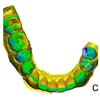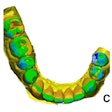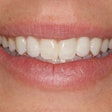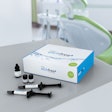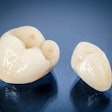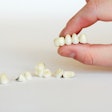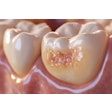One of the conclusions that I have come to in 10 years of practice is that a reliable glass ionomer is an essential tool that every dentist needs in their arsenal. Now, admittedly, I have probably used glass ionomer more than most of my colleagues of similar age throughout my career.
 Dr. Danny Snyder.
Dr. Danny Snyder.
Two years out of dental school, I took over for an incredible 71-year-old dentist who had built an amazing practice over 41 years. So naturally, my patient population was on the more experienced side, with more than half of them being over age 70. And even though the dental IQ and home care of those patients was higher than average, I saw, and was tasked with coming up with solutions for, a lot of root caries.
In the beginning, I would rubber dam, pack cord, and sometimes even air abrade before placing beautiful composite restorations that polished nicely and matched the tooth shade perfectly. But after a year of seeing many of those perfect class V fillings fall out or develop recurrent decay, I decided that I needed to start placing restorations that could reliably adhere to dentin.
At the time, however, there were major trade-offs with working with glass ionomer. The low viscosity meant that I was at the mercy of preformed cervical matrices, Toffelmire bands, or trying to wait the perfect amount of time between when it started to set up and when it set up fully (the last one never worked, by the way).
With a lot of practice, I developed a system where my longtime assistants and I were able to place really great restorations, and I even converted almost all of my crown buildups to glass ionomer due to the fluoride release and its superior bond to dentin.
Although the restorations lasted longer and helped prevent decay, their appearance still left much to be desired. They were opaque, lacked good color-matching, and were difficult to polish.
Enter SDI Riva Light Cure, a revolutionary resin-reinforced glass ionomer that has all of the upside of a traditional glass ionomer (superior bond to dentin, fluoride release, decreased sensitivity, etc.) but with all the advantages of composite resin (workability, translucency, color-matching, polishability, etc.).
As I started to incorporate Riva Light Cure into my daily practice, I immediately fell in love with the fact that it comes in regular viscosity and high viscosity (HV) formulation, the latter being packable like your favorite resin composite.
There are times when my class V prep perfectly mimics the shape of the preformed cervical matrices I mentioned earlier. When that’s the case, I love a more flowable option, and the Riva LC is perfect in this situation.
I have confidence that when I have the matrix tucked under the gumline, fill the prep with the Riva LC glass ionomer, and then press and seal the matrix against the tooth with the excess spilling out the top, that the material is getting maximum contact and bond with the dentin.
The excess is easily removed with a flame bur, and the rest of the restoration formed by the matrix has a perfect finish. I also find the Riva LC works great as a base or liner where a flowable composite may have been used previously.
But if you ask me where this product really shines, I would say that the Riva LC HV glass ionomer has been a game changer. I mentioned earlier that I used to unsuccessfully wait a minute or more to extrude other low-viscosity glass ionomers in hopes that it would be partially set up and thus be easier to work with.
The problem was that it would have a chalky feel and have poor adhesion. The Riva LC HV behaves very similarly to a traditional resin composite; it is the perfect material for all class V restorations and in select situations can even be used for class I, II, and III fillings.
And since it is light-cured, you have a lot more working time than I had with my old glass ionomer. While I will admit that I have not completely switched over to Riva Light Cure for all class I and II restorations, I am happy to report that it has helped tremendously in a few critical instances.
I recently had a patient who had fillings placed by my expanded function dental assistant. The patient returned a few weeks later with extreme sensitivity.
We took radiographs and checked the occlusion, and everything looked good. In the end, I redid the fillings myself, making sure to place very small layers to hopefully avoid further sensitivity. Unfortunately, the sensitivity persisted, and the patient returned a couple of weeks later.
At this point, I had been using the Riva LC HV for about a month, and I offered to replace the fillings once more, this time using this new material. The patient reported almost immediate relief of her symptoms. I love having this new material in my toolbox as a possible solution for instances just like this.
I mentioned earlier how I’ve always liked to use glass ionomer for crown buildups. That’s another area where the versatility of having two viscosity options has been really appreciated.
As we all know, some buildups are large and some are small. Previously, I would always put a Toffelmire band around a tooth when placing any buildup, big or small, because the low viscosity meant that it could flow out anywhere. Now, I often will use the Riva LC HV where the area being built up is accessible, and I can use my composite instruments to shape and adapt it without needing to band the tooth.

One hundred percent of our evaluators highly rated the consistency and adaptability of the product. Over 90% noted that it extruded more reliably and adapted to the cavity prep better than other products on the market.
Similarly, like me, over 90% of our evaluators appreciated the versatility of Riva Light Cure and its ability to be placed on a number of different tooth surfaces.
Finally, going back to my previous admission that my old glass ionomer left my class V restorations looking opaque and poorly color-matched, I love how the superior color and translucency of Riva Light Cure often blends seamlessly, leaving my handiwork unnoticed (just how I like it)!
 A 17-year-old boy, who reported drinking several energy drinks per day, presented with class V lesions throughout his mouth. Riva's high viscosity formula restores beautifully and matches the character of the surrounding teeth. Images and captions courtesy of Dr. Danny Snyder.
A 17-year-old boy, who reported drinking several energy drinks per day, presented with class V lesions throughout his mouth. Riva's high viscosity formula restores beautifully and matches the character of the surrounding teeth. Images and captions courtesy of Dr. Danny Snyder.
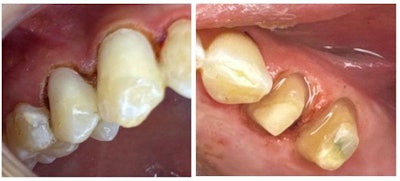
 Buildups on teeth #12 and #13 with a Toffelmire band and Riva's low viscosity product. Riva adapts perfectly and preps nicely.
Buildups on teeth #12 and #13 with a Toffelmire band and Riva's low viscosity product. Riva adapts perfectly and preps nicely.
Dr. Danny Snyder grew up in Alpine, UT, where he loved playing sports and spending time outdoors. He received his undergraduate degree in marriage, family, and human development from Brigham Young University and his Doctor of Medicine in Dentistry degree from the University of Louisville. Snyder is the inventor of the Slate Electric Flosser.
The comments and observations expressed herein do not necessarily reflect the opinions of DrBicuspid.com, nor should they be construed as an endorsement or admonishment of any particular idea, vendor, or organization.



